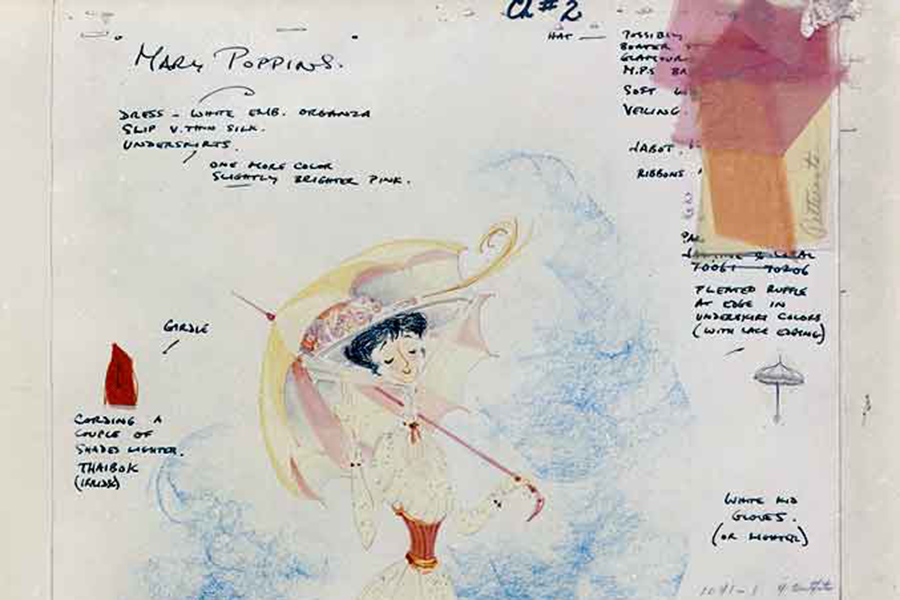[cycloneslider id=”mary-poppins”]
MARY POPPINS INTERVIEW
Set and costume designer Tony Walton is one of a select group to have won the trifecta of the entertainment world. He has an Oscar for “All That Jazz,” an Emmy for the TV adaptation of “Death of a Salesman” and Tony awards for “Pippin,” “House of Blue Leaves” and “Guys and Dolls.”
His first Oscar nomination came with his first movie gig creating the costumes and acting as visual consultant for “Mary Poppins.” Working with his then-wife, Julie Andrews, under the supervision of Walt Disney was such an indelible experience that 48 years later Walton remembers it as if it just happened.
Before heading for San Francisco to speak at the Walt Disney Family Museum and the Museum of Performance & Design, Walton, 77, talked about a certain flying governess and why he and Andrews were up in the air about taking on the project.
Q:Walt Disney himself tried to lure your then-wife into playing Mary Poppins. Why was she so resistant?
A: Julie wanted to play the lead in “My Fair Lady” and did not want to commit to “Mary Poppins” until it was clear who would get that part. We found out accidentally when we went to visit her L.A. agents at MCA. At some point, all the young Turks (in the office) came barreling down the corridor and announced, “We did it. We got Audrey Hepburn for Eliza.” Julie’s agent turned to them and said, “This is Julie Andrews.”
Q:You also needed to be talked into “Mary Poppins.”
A: We had done Julie’s television series in London, and while it was great fun working together it also was a little dangerous because it upset our normal routine of one being available to the other at a time of pressure. We decided to not work simultaneously on the same production. Walt recognized this and made allowances for it. The design work was pretty much completed before the actors went before the camera.
Q:How involved was Disney with the film?
A: He was totally involved in every aspect. He used to do little drawings on how special effects could be achieved. Primitive as they were, they made very clear that frequently he was the one who came up with inventive ideas, like when Uncle Albert (Ed Wynn) floats on the ceiling and the kids join him. He also suggested that for a lot of flying, instead of a flying rig the performers just sit on one end of a teeter-totter and on the other end you could manipulate their swaying. The camera just cuts in around the bust so you don’t see any mechanism.
Q:One of the great innovations of the movie is changing the time frame from the 1930s, when the book was set, to the Edwardian era. How did you feel about designing for that period?
A: I love the turn-of-the-century look and had on many occasions worked on things by Shaw or Oscar Wilde. I wish I had been born into that period. I loved to design for it so that was a godsend to me. My most fortunate notion was giving Mary Poppins a secret life. I showed this by making her clothes gray or black or slate but showing she had a secret life by their linings, which were always flashes of crimson or some very bright color. Julie loved that idea and really made good use of it.
Q:Did any of the actors let you know how they thought they should look?
A: When Glynis Johns came to our first meeting she said, “Now Tony, I know I am playing a suffragette but we are going to make me pretty aren’t we?”
Q:You worked with the well-known costume maker Elizabeth Courtney. What did she contribute?
A: She went to extraordinary trouble to make sure everyone was comfortable in their clothes- even the stuntmen who played the nannies and who got blown away. Stunt gals didn’t really exist at that time.
Q:You and Julie Andrews divorced in 1967 after eight years of marriage, but you have stayed close and have worked on children’s books together, along with your daughter, Emma. What is your secret to maintaining a good relationship?
A: Well of course it is Emma. She is our baby, and we did very much want to make sure we were always in touch because of her. When she would come to stay with me for a period of time, Julie would send her with a little story they had made up together, and Emma and I would illustrate it together. One of those stories became a book called “Simeon’s Gift.”

